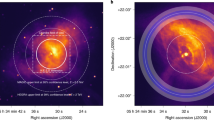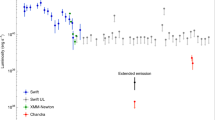Abstract
THE compact low-frequency radio source1 in the Crab nebula is exceptional in most of its properties. Its spectral index2 of ∼ 1.75 between 26.5 and 1,407 MHz is the highest known for a galactic continuum source, and its brightness temperature of ∼ 1014 K at 38 MHz implies an unusual emission mechanism with a high volume emissivity. The high spectral index suggests that only a small fraction of the total radio luminosity of the source may have been observed in the frequency range studied so far. The error field of its radio position3 contains the pulsar NP 0532, and these objects may therefore be related; if the relationship were substantiated, it would be the only continuum source of small angular size known to coincide with a pulsar. This report presents evidence that the high spectral index is maintained to 10 MHz.
This is a preview of subscription content, access via your institution
Access options
Subscribe to this journal
Receive 51 print issues and online access
$199.00 per year
only $3.90 per issue
Buy this article
- Purchase on Springer Link
- Instant access to full article PDF
Prices may be subject to local taxes which are calculated during checkout
Similar content being viewed by others
References
Andrew, B. H., Branson, N. J. B. A., and Wills, D., Nature, 203, 171 (1964).
Bell, S. J., and Hewish, A., Nature, 213, 1214 (1967).
Gower, J. F. R., Nature, 213, 1213 (1967).
Trimble, V. L., Astron. J., 73, 535 (1968).
Bridle, A. H., and Purton, C. R., Astron. J., 73, 717 (1968).
Bridle, A. H., and Venugopal, V. R., Nature, 224, 545 (1969).
Bridle, A. H., Nature, 221, 648 (1969).
Sharpless, S., in Stars and Stellar Systems (edit. by Blaauw, A., and Schmidt, M.), 5, 316 (University of Chicago Press, 1965).
Hjellming, R. M., Gordon, C. P., and Gordon, K. J., Astron. Astrophys., 2, 202 (1969).
Bazelyan, L. L., Braude, S. Ya., Bruck, Yu. M., Zhouck, I. N., Megn, A. V., Ryabov, B. P., Sodin, L. G., and Sharykin, N. K., Radiofizika, 6, 897 (1963).
Braude, S. Ya., Lebedeva, O. M., Megn, A. V., Ryabov, B. P., and Zhouck, I. N., Mon. Not. Roy. Astron. Soc., 143, 289 (1969).
Roger, R. S., Costain, C. H., and Lacey, J. D., Astron. J., 74, 366 (1969).
Erickson, W. C., and Cronyn, W. M., Astrophys. J., 142, 1156 (1965).
Williams, P. J. S., Kenderdine, S., and Baldwin, J. E., Mem. Roy. Astron. Soc., 70, 53 (1966).
Parker, E. A., Mon. Not. Roy. Astron. Soc., 138, 407 (1968).
Matveenko, L. I., Astron. Zh., 45, 695 (1968), trans, in Sov. Astron. AJ, 12, 552 (1968).
Rees, M. J., Astrophys. Lett., 2, 1 (1968).
Burbidge, G. R., and Hoyle, F., Nature, 221, 847 (1969).
Ginzburg, V. L., and Ozernoi, L. M., Radiofizika, 9, 221 (1966).
Kaplan, S. A., Astrofizika, 2, 409 (1966).
Comella, J. M., Craft, H. D., Lovelace, R. V. E., Sutton, J. M., and Tyler, G. L., Nature, 221, 453 (1969).
Scheuer, P. A. G., Nature, 218, 920 (1968).
Author information
Authors and Affiliations
Rights and permissions
About this article
Cite this article
BRIDLE, A. Low-frequency Spectrum of the Crab Nebula. Nature 225, 1035–1037 (1970). https://doi.org/10.1038/2251035a0
Received:
Issue Date:
DOI: https://doi.org/10.1038/2251035a0
This article is cited by
-
A New Look at Type-III Bursts and Their Use as Coronal Diagnostics
Solar Physics (2015)
-
Low-frequency radio spectra of crab nebula, Virgo A, and Cygnus A
Radiophysics and Quantum Electronics (1996)
-
The crab nebula
Astrophysics and Space Science (1973)
-
Generation of Radio Waves in Pulsars
Nature (1970)
-
Observation of the radio emission of the pulsar NP 0532 at a frequency of 25 MHz
Radiophysics and Quantum Electronics (1970)
Comments
By submitting a comment you agree to abide by our Terms and Community Guidelines. If you find something abusive or that does not comply with our terms or guidelines please flag it as inappropriate.



